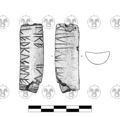SZ-22 antler: Difference between revisions
Sindy Kluge (talk | contribs) No edit summary |
Sindy Kluge (talk | contribs) No edit summary |
||
| (6 intermediate revisions by 2 users not shown) | |||
| Line 2: | Line 2: | ||
|type_object=handle | |type_object=handle | ||
|material=antler | |material=antler | ||
|dimension=length 5. | |dimension=length: 5.5 cm, width: 1.9 cm, thickness: 1 cm | ||
|dimension_max=5. | |dimension_max=5.5 cm | ||
|condition=fragmentary | |condition=fragmentary | ||
|culture_archaeological=Late Iron Age | |culture_archaeological=Late Iron Age | ||
|sortdate=-250 | |||
|date=5th–1st centuries BC | |||
|date_derivation=cultural context | |date_derivation=cultural context | ||
|site=Sanzeno | |site=Sanzeno | ||
| Line 13: | Line 15: | ||
|inventory_number=13.454 | |inventory_number=13.454 | ||
|accessibility=on exhibition | |accessibility=on exhibition | ||
|source= Zemmer-Plank et al. 1985: 166 | |source=Zemmer-Plank et al. 1985: 166 [cat. No. 41] | ||
|checklevel=0 | |checklevel=0 | ||
}} | }} | ||
== Commentary == | == Commentary == | ||
Antler fragment.<br>Probably handle of a knife or another implement.<br>Semi-circular cross section; curved side smoothed, flat side not worked, therefore rough. On both ends broken at which one end is slivered. Three longitudinal grooves as well as horizontal | Antler fragment.<br>Probably handle of a knife or another implement.<br>Semi-circular cross section; curved side smoothed, flat side not worked, therefore rough. On both ends broken at which one end is slivered. Three longitudinal grooves as well as horizontal notches in the area of this end. On the other side remains of a perforation.<br>The above-mentioned dimensions result of the autopsy by the ''{{SITENAME}}''.<br>On the curved side an [[index::SZ-22.1|inscription]] in two lines; on the flat side also [[index::SZ-22.2|characters]].<br>Mancini notes that the [[SZ-22 antler|object]] was found in two pieces in November 1908 in [[index::Sanzeno]] without giving further information (cp. {{bib|LIR}}: 93).<br>The dating to the Late Iron Age is reasoned by the appearance of the [[index::SZ-22|inscription]].<br>Doubts in matters of the material: The literature, e.g. {{bib|Franz 1957}}: 107 fn. 19, who contradicts directly the statement of Mayr, {{bib|Zemmer-Plank et al. 1985}}: 166, and {{bib|Nothdurfter 2002}}: 1151, characterises it as made of bone. The [[index::Tiroler Landesmuseum Ferdinandeum|museum]] as well as {{bib|Mayr 1956b}}: 246 describe the object as made of antler.<br>Also various interpretations related to the function: {{bib|Zemmer-Plank et al. 1985}}: 166, as well as {{bib|Nothdurfter 2002}}: 1151 note it as handle; the [[index::Tiroler Landesmuseum Ferdinandeum|museum]] identifies it with a votive offering and {{bib|Mayr 1956b}}: 246 indicates the two suggestions as possible. It is probable that the fragment was a handle related to the primary function, however later it was dedicated as votive offering. Probably therefore the [[index::SZ-22.2|characters]] on the flat side.<br>In the recently released study about the Raetic inscriptions by Marchesini the [[SZ-22 antler|antler handle]] is listed with "MLR 165", an autopsy was effected (cp. {{bib|MLR}}: 174 [MLR 165]).<br>Autopsied by the ''Thesaurus Inscriptionum Raeticarum'' in November 2013. | ||
{{sig | |||
|user=Sindy Kluge | |||
}} | |||
{{bibliography}} | {{bibliography}} | ||
Latest revision as of 17:01, 1 March 2016
| Object | |
|---|---|
| Classification: | handle |
| Material: | antler |
| Size: | length: 5.5 cm, width: 1.9 cm, thickness: 1 cm |
| Condition: | fragmentary |
| Archaeological culture: | Late Iron Age |
| Date: | 5th–1st centuries BC |
| Date derived from: | cultural context |
|
| |
| Site: | Sanzeno (Trento, Trentino-Alto Adige, Italy) |
| Coordinates (approx.): | 46° 21' 57.60" N, 11° 4' 30.00" E [from site] |
| Find date: | November 1908 |
| Find circumstances: | old finding |
| Current location: | Tiroler Landesmuseum Ferdinandeum (on exhibition) |
| Inventory Nr.: | 13.454 |
|
| |
| Inscriptions: | |
|
| |
| Sources: | Zemmer-Plank et al. 1985: 166 [cat. No. 41] |
Images
|
|
Commentary
Antler fragment.
Probably handle of a knife or another implement.
Semi-circular cross section; curved side smoothed, flat side not worked, therefore rough. On both ends broken at which one end is slivered. Three longitudinal grooves as well as horizontal notches in the area of this end. On the other side remains of a perforation.
The above-mentioned dimensions result of the autopsy by the Thesaurus Inscriptionum Raeticarum.
On the curved side an inscription in two lines; on the flat side also characters.
Mancini notes that the object was found in two pieces in November 1908 in Sanzeno without giving further information (cp. LIR: 93).
The dating to the Late Iron Age is reasoned by the appearance of the inscription.
Doubts in matters of the material: The literature, e.g. Franz 1957: 107 fn. 19, who contradicts directly the statement of Mayr, Zemmer-Plank et al. 1985: 166, and Nothdurfter 2002: 1151, characterises it as made of bone. The museum as well as Mayr 1956b: 246 describe the object as made of antler.
Also various interpretations related to the function: Zemmer-Plank et al. 1985: 166, as well as Nothdurfter 2002: 1151 note it as handle; the museum identifies it with a votive offering and Mayr 1956b: 246 indicates the two suggestions as possible. It is probable that the fragment was a handle related to the primary function, however later it was dedicated as votive offering. Probably therefore the characters on the flat side.
In the recently released study about the Raetic inscriptions by Marchesini the antler handle is listed with "MLR 165", an autopsy was effected (cp. MLR: 174 [MLR 165]).
Autopsied by the Thesaurus Inscriptionum Raeticarum in November 2013.
Bibliography
| Franz 1957 | Leonhard Franz, "Südtiroler Reitia-Inschriften", Der Schlern 31 (1957), 105–109. |
|---|---|
| LIR | Alberto Mancini, Le Iscrizioni Retiche [= Quaderni del dipartimento di linguistica, Università degli studi di Firenze Studi 8–9], Padova: Unipress 2009–10. (2 volumes) |
| Mayr 1956b | Karl M. Mayr, "Hirschhornvotive aus den rätischen Bergen", Der Schlern 30 (1956), 245–246. |
